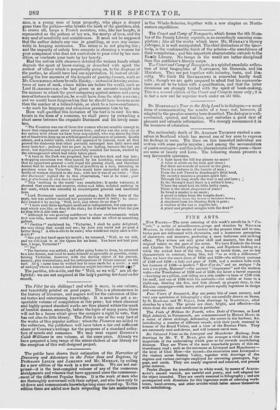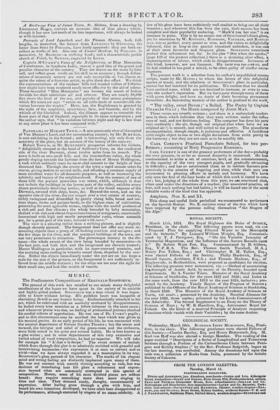FINE ARTS.
NEW PRINTS.— The most amusing of this week's novelties is " C asts," a series of miscellaneons■scraps and sketches by NJAI.MAR MOSNER., in which the modes of society at the present time and in cen. tunes past are delineated with cleverness, and a humorous perception of characters and manners,, producing a most ludicrous and striking effect. They evince not only great skill and mastery, but fine and original talent on the part of the artist. We have Frederic the Great and Charles the Twelfth playing at chess, and Napoleon looking on ; while the cocked bats of the trio, hung up beside them, are no less characteristic in contrast, being like, but "so as with a difference." Then we have the court-dress of 1630 and 1830—the military costume of 1530 and 1830—a lady and page of 1530, and a modern belle with her footman of 1830—a modern "flow d'ye do," and an antique "Jo suis a vos pieds, Madame"—the ancient " cinque-pace" and the modern waltz—the Troubadour of 1330 and of 1830, the latter a barrel-organist —hawking on a pillion and riding on a side saddle—a beau of 1720 with his muff, and one of 17830 with his umbrella—the, soldier at home in a night-cap, blowing the fire, and him abroad, on picquet duty, in the Russian campaign—with many other points equally ingenious in design and execution.
Four Views of Swanwich, Bay are pretty bits of coast scenery, and very nice specimens of lithography ; they are carefully drawn on Stone, by G. BARNAHD and W. GAuct, from drawings by GASTINEAU, after sketches by a lady. The prints are clear, bright, and effective—the views from the east and north-east in particular.
The rsits of William the Fourth, when Duke of Clarence' as Lord High Admiral, to Portsmouth, are commemorated by HENRY MOSES in a series of clever etchings, delineating the scenes in the harbour, &c. introducing a number of different vessels, with their yards manned in honour of the Royal Visitor, and a view of the Russian Fleet. They are extremely neat and clever, and will interest naval men.
Six Coloured Views on the Liverpool and Manchester Railway, from drawings by Mr. T. T. Boar, give the stranger a vivid idea of the magnitude of the undertaking which goes so far towards annihilating distance. They are Views of the most remarkable points of this ex- traordinary road ; such as the entrances at Liverpool and Manchester— the level of Chat Moss—the tunnel—the excavation near Liverpool— the viaduct across Sankey Valley, together with drawings of the engines and various carriages employed for conveying passengers, lug- gage, and cattle. They are neatly engraved and coloured, and possess great interest.
Twelve Designs for, transferring to white wood, by means of ACHSR... DIANN'S caustic varnish, are tasteful and pretty, and well adapted for the object intended. They are neatly executed in lithography ; and are, accompanied with directions for this ingenious mode of adorning work- boxes, hand-screens,, and other articles.which ladies amuse- themselves with embellishing.
. -
• Captain M'Cuan v.'s Views of the Neilyherries, or Blue Mountains of Coimbetoor, in Southern India, convey a good idea of the grand and peculiar character of the scenery. They are drawn on the stone by him- self, and reflect great credit on his skill as an amateur ; though deline- ations of mountain scenery are not only susceptible of, but almost re- quire the talent of a first-rate artist, to give them due effect. We think the representations of the verdant hills and wooded vallMs of Colmbe. toor might have been rendered much more effective by the aid of colour. These beautiful "Blue Mountains" are become the resort of Indian invalids for their Salubrious air and climate. They are nearly 10,000 feet above the level of the sea, and partake of that serene atmosphere which HUMBOLDT says "exists on all table-lands of considerable ele- vation between the tropics." Here, too, the Englishman is greeted by the sight of the raspberry, strawberry, fern, and bramble, and by the whistle of the blackbird. Indeed, the climate appears to resemble the finest part of that of England, especially in its mean temperature ; and the author says, that "its variation between night and day is less than at any other place it has been compared with." A Bird's-eye View of James Town, St. Helena, from a drawing by Lieutenant BLAjiE, conveys an accurate idea of that place ; which, though it has now lost much of its late importance, will always be looked at with interest.
Portraits of Lord Lynedoch and Sir Thomas Munro, both full- lengths, in mezzotint, the former from LAWRENCE by REYNOLDS, the latter from SHEE by PHILLIPS, have lately appeared : they are both ex- cellent as works of art. Also one of Colonel Denham, by PHILLIPS, in mezzotint, by Bacot:my—a striking head ; and a characteristic profile sketch of Pauli, by NEWTON, engraved by LEWIS.



























 Previous page
Previous page